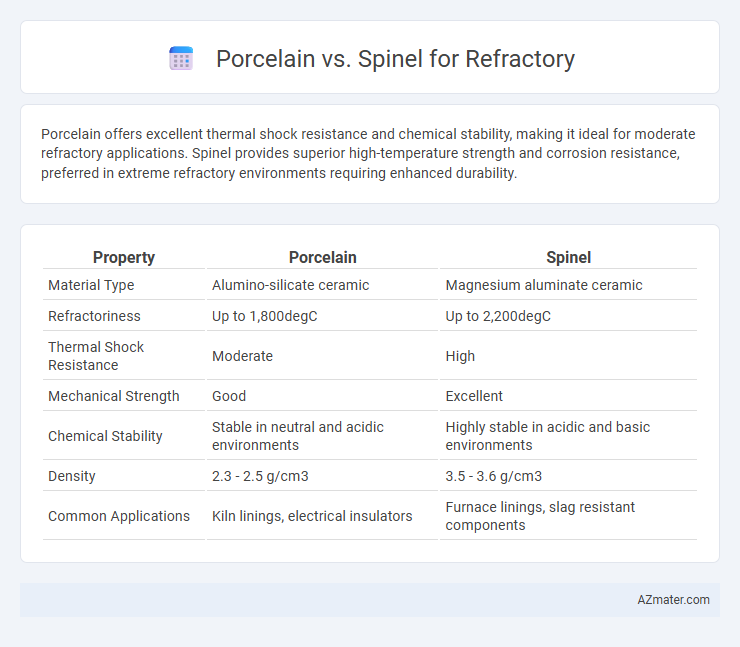Porcelain offers excellent thermal shock resistance and chemical stability, making it ideal for moderate refractory applications. Spinel provides superior high-temperature strength and corrosion resistance, preferred in extreme refractory environments requiring enhanced durability.
Table of Comparison
| Property | Porcelain | Spinel |
|---|---|---|
| Material Type | Alumino-silicate ceramic | Magnesium aluminate ceramic |
| Refractoriness | Up to 1,800degC | Up to 2,200degC |
| Thermal Shock Resistance | Moderate | High |
| Mechanical Strength | Good | Excellent |
| Chemical Stability | Stable in neutral and acidic environments | Highly stable in acidic and basic environments |
| Density | 2.3 - 2.5 g/cm3 | 3.5 - 3.6 g/cm3 |
| Common Applications | Kiln linings, electrical insulators | Furnace linings, slag resistant components |
Introduction to Refractory Materials
Refractory materials, essential for withstanding extreme temperatures in industrial processes, commonly include porcelain and spinel due to their thermal stability and durability. Porcelain offers excellent chemical resistance and low thermal conductivity, making it suitable for insulating applications. Spinel, composed of magnesium aluminate, boasts superior mechanical strength and resistance to thermal shock, ideal for high-stress environments requiring robust performance.
Defining Porcelain and Spinel
Porcelain is a highly durable ceramic material composed mainly of kaolin, quartz, and feldspar, known for its excellent thermal insulation and resistance to chemical corrosion in refractory applications. Spinel, a magnesium aluminate mineral (MgAl2O4), offers superior thermal stability, mechanical strength, and resistance to slag corrosion, making it ideal for high-temperature refractory linings. Both materials are essential in refractory engineering, with porcelain favored for insulation and spinel preferred for structural durability and slag resistance.
Key Properties Comparison: Porcelain vs Spinel
Porcelain exhibits excellent thermal shock resistance and chemical stability, making it suitable for moderate refractory applications, while Spinel offers superior high-temperature strength and enhanced resistance to slag and corrosion, ideal for aggressive environments. Porcelain's lower thermal conductivity provides better insulation, whereas Spinel's higher melting point and hardness contribute to its durability under extreme conditions. Both materials differ in density and mechanical strength, with Spinel generally outperforming porcelain in wear resistance and longevity within refractory linings.
Thermal Resistance and Stability
Porcelain exhibits excellent thermal resistance withstanding temperatures up to 1400degC, making it suitable for moderate refractory applications, but it may suffer from thermal shock due to lower mechanical strength. Spinel, composed primarily of magnesium aluminate, offers superior thermal stability and resistance beyond 1600degC, maintaining structural integrity under rapid temperature fluctuations. The higher melting point and robust chemical inertness of spinel make it ideal for high-performance refractory linings in steel and glass manufacturing industries.
Mechanical Strength and Durability
Spinel exhibits superior mechanical strength compared to porcelain, making it more resistant to thermal shock and mechanical stress in refractory applications. The high melting point and excellent corrosion resistance of spinel contribute significantly to its enhanced durability under extreme temperature conditions. Porcelain, while offering good insulating properties, tends to have lower fracture toughness and can degrade faster when exposed to aggressive refractory environments.
Chemical Resistance in Harsh Environments
Porcelain and spinel both offer chemical resistance for refractory applications, but spinel exhibits superior stability in harsh environments due to its higher resistance to acidic and basic slags. Porcelain can degrade when exposed to strong alkalis and aggressive chemicals over prolonged periods, limiting its effectiveness. Spinel's crystalline structure provides enhanced durability and longer service life under corrosive conditions commonly found in metallurgical processes.
Manufacturing Process and Material Cost
Porcelain for refractory applications is manufactured through high-temperature firing of kaolin clay, quartz, and feldspar, resulting in a dense, vitrified material with excellent thermal insulation but moderate mechanical strength; its production involves relatively low raw material costs and established kiln technologies. Spinel refractory, mainly composed of magnesium aluminate (MgAl2O4), requires advanced sintering or fusion processes at temperatures above 1600degC, making the manufacturing more complex and energy-intensive, leading to higher material and production costs. While porcelain offers cost-efficiency and ease of manufacture, spinel provides superior thermal stability and corrosion resistance, justifying its premium price in demanding refractory environments.
Common Industrial Applications
Porcelain and spinel are widely used in refractory applications due to their high-temperature resistance and durability. Porcelain is commonly utilized in electrical insulators, kiln linings, and chemical processing equipment, benefiting from its excellent dielectric properties and thermal shock resistance. Spinel, often employed in furnace linings, crucibles, and cement rotary kiln components, provides superior mechanical strength and corrosion resistance in aggressive environments, making it ideal for high-performance industrial applications.
Pros and Cons of Porcelain and Spinel
Porcelain offers excellent thermal stability and resistance to chemical corrosion, making it ideal for insulating applications in moderate temperature ranges, but it can be brittle and prone to mechanical damage under high stress. Spinel provides superior thermal shock resistance and mechanical strength at elevated temperatures, enhancing durability in harsh refractory environments, though it typically involves higher production costs and complex manufacturing processes. Selecting between porcelain and spinel depends on balancing thermal performance requirements against mechanical stress and cost constraints in refractory applications.
Choosing the Right Material for Your Refractory Needs
When selecting between porcelain and spinel for refractory applications, consider thermal stability and chemical resistance as key factors; spinel offers superior performance in high-temperature and corrosive environments due to its excellent refractory properties and high melting point of approximately 2135degC. Porcelain, while cost-effective and moisture-resistant, may lack the durability required for extreme industrial conditions. Prioritize spinel for applications demanding enhanced mechanical strength and longevity in aggressive refractory settings.

Infographic: Porcelain vs Spinel for Refractory
 azmater.com
azmater.com